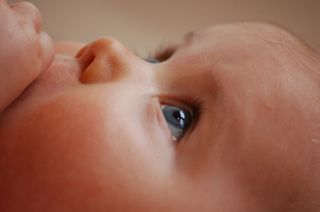What Our Faces Say to Our Children
Here's how our faces can be an important source of information for babies.
by Vanessa LoBue Ph.D.One of the most famous psychologists of all time, William James, described a baby’s first experiences with the world as a “blooming, buzzing confusion.” Indeed, when they are first born, babies need help from caregivers in order to learn the skills they need to function in a complex world. But where do they begin? How do they start to make sense of this blooming, buzzing confusion?

An important source of information for babies from the very first days of life is human faces. As if nature is giving us a hint about where important information might come from, babies are born with a preference for face-like shapes (Johnson & Morton, 1991), and in fact, there is evidence that this preference develops before the baby is even born (Reid, Dunn, Young, Amu, Donovan, & Reissland, 2017). A few months later, they not only prefer to look at faces over most other things but they also especially prefer the faces that are most familiar to them, like their mother’s face (Maurer & Salapatek, 1976). At first, when babies look at faces, they mostly scan the parts of the face that have the most contrast in color, like around the hairline, but as they get older, they look at the parts of the face that have the most information, like the eyes (Maurer & Salapatek, 1976). Then later (as they begin to learn the language), they look more and more at the mouth (Hunnius & Geuze, 2004).
This preference for faces helps babies learn to identify their loved ones early on and directs them to the most important information in the surrounding environment. For example, faces give babies a clue for what kinds of objects are alive and may have thoughts. Indeed, infants often use faces to decide whether an object has intentions (Johnson, Slaughter, & Carey, 1998). Relatedly, given that we tend to look at the things we find most interesting or important, infants’ early focus on looking at the eyes of a face could provide them with information about what they should be looking at as well. Babies start to understand that eyes are a cue for intention sometime between 6 and 12 months of age when they begin to follow the gaze of adults, looking wherever adults look (Deák, 2015).
Next, infants learn to use facial features besides the eyes for information about what to do in social situations, one of the most powerful of which is emotional expressions. Newborns develop the ability to discriminate between various emotional expressions pretty early on, including happy, sad, and surprised faces, only shortly after birth (Field, Woodson, Greenburg, & Cohen, 1982). Between 12 to 18 months of age, babies learn how to use information from the mothers’ facial expressions as a signal for what to do in new situations. For example, babies avoid playing with a new toy if they see an adult react fearfully toward it (Mumme & Fernald, 2003; Mumme, Fernald, & Herrera, 1996). The same is true for a drop-off or step of a potentially dangerous height: If babies see their mothers pose a negative or fearful face in response to the drop-off, they won’t try to descend (Sorce, Emde, Campos, & Klinnert, 1985; Tamis-LeMonda, Adolph, Lobo, Karasik, Dimitropoulou, & Ishak, 2008).
Importantly, all of the information that babies can glean from faces has implications for learning and how they interact with other people. First, the ability to interpret facial expressions matters for overall emotional competence—or how children learn to express and control those emotions and recognize the emotions of other people. Emotional competence is an important predictor of all sorts of positive outcomes for children, including starting and maintaining positive social relationships and academic performance (Denham, 2019).
Importantly, talking about emotions predicts emotional competence. By 3 to 5, children can name most emotional expressions (Widen, 2013; Widen & Russell, 2008). Talking to children about these expressions might help them to accurately identify the emotions of others and, in the end, be able to engage in healthier social interactions with their parents and peers.
Further, this body of research implies that parents should be aware that from an early age, babies look at our faces for guidance about how to behave. For example, just like infants can learn to avoid a toy or dangerous drop-off by looking at their mothers’ faces for information, there is evidence that they might also develop fears from the same types of interactions (Broeren, Lester, Muris, & Field, 2011; Askew & Field, 2007). In other words, if a baby or child watches a parent react with fear towards a spider on the floor, they could reasonably learn to be afraid of spiders as well. This is also true for things that we say in front of children—if we say that spiders are scary, our children might learn to react to spiders with fear (Field & Lawson, 2003; Field & Schorah, 2007).
Given that infants have a lot to learn, the faces of those who are familiar to them will consistently be an important source of information. They tell babies who’s familiar and who’s not, what we’re thinking, what we’re feeling, and what to do when things are uncertain. Further, the ability to interpret facial expressions can be an important guide for children about what to expect from a social situation. In this way, the kinds of messages we send with our faces can be powerful tools for learning, so perhaps it’s important to be aware of the faces we wear, especially in front of babies.